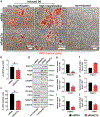Rab27a Regulates Human Perivascular Adipose Progenitor Cell Differentiation
- PMID: 30105417
- PMCID: PMC6542275
- DOI: 10.1007/s10557-018-6813-y
Rab27a Regulates Human Perivascular Adipose Progenitor Cell Differentiation
Abstract
Purpose: Perivascular adipose tissue (PVAT) surrounds blood vessels and regulates vascular tone through paracrine secretion of cytokines. During conditions promoting cardiometabolic dysfunction, such as obesity, cytokine secretion is altered towards a proinflammatory and proatherogenic profile. Despite the clinical implications for cardiovascular disease, studies addressing the biology of human PVAT remain limited. We are interested in characterizing the resident adipose progenitor cells (APCs) because of their potential role in PVAT expansion during obesity. We also focused on proteins regulating paracrine interactions, including the small GTPase Rab27a, which regulates protein trafficking and secretion.
Methods: PVAT from the ascending aorta was collected from patients with severe cardiovascular disease undergoing coronary artery bypass grafting (CABG). Freshly-isolated PVAT was digested and APC expanded in culture for characterizing progenitor markers, evaluating adipogenic potential and assessing the function(s) of Rab27a.
Results: Using flow cytometry, RT-PCR, and immunoblot, we characterized APC from human PVAT as negative for CD45 and CD31 and expressing CD73, CD105, and CD140A. These APCs differentiate into multilocular, UCP1-producing adipocytes in vitro. Rab27a was detected in interstitial cells of human PVAT in vivo and along F-actin tracks of PVAT-APC in vitro. Knockdown of Rab27a using siRNA in PVAT-APC prior to induction resulted in a marked reduction in lipid accumulation and reduced expression of adipogenic differentiation markers.
Conclusions: PVAT-APC from CABG donors express common adipocyte progenitor markers and differentiate into UCP1-containing adipocytes. Rab27a has an endogenous role in promoting the maturation of adipocytes from human PVAT-derived APC.
Keywords: Adipose; Cardiovascular; Disease; Perivascular; Progenitor; Rab27a.
Conflict of interest statement
Figures




Similar articles
-
Differentiation Capacity of Human Aortic Perivascular Adipose Progenitor Cells.J Vis Exp. 2019 Mar 5;(145):10.3791/59337. doi: 10.3791/59337. J Vis Exp. 2019. PMID: 30907879 Free PMC article.
-
The distribution and adipogenic potential of perivascular adipose tissue adipocyte progenitors is dependent on sexual dimorphism and vessel location.Physiol Rep. 2016 Oct;4(19):e12993. doi: 10.14814/phy2.12993. Physiol Rep. 2016. PMID: 27738018 Free PMC article.
-
Effects of a Global Rab27a Null Mutation on Murine PVAT and Cardiovascular Function.Arterioscler Thromb Vasc Biol. 2024 Jul;44(7):1601-1616. doi: 10.1161/ATVBAHA.124.320969. Epub 2024 Apr 25. Arterioscler Thromb Vasc Biol. 2024. PMID: 38660803 Free PMC article.
-
The pathobiology of perivascular adipose tissue (PVAT), the fourth layer of the blood vessel wall.Cardiovasc Pathol. 2022 Nov-Dec;61:107459. doi: 10.1016/j.carpath.2022.107459. Epub 2022 Jul 28. Cardiovasc Pathol. 2022. PMID: 35907442 Review.
-
Perivascular Adipose Tissue: the Sixth Man of the Cardiovascular System.Cardiovasc Drugs Ther. 2018 Oct;32(5):481-502. doi: 10.1007/s10557-018-6820-z. Cardiovasc Drugs Ther. 2018. PMID: 30171461 Free PMC article. Review.
Cited by
-
Perivascular Adipose Tissue Regulates Vascular Function by Targeting Vascular Smooth Muscle Cells.Arterioscler Thromb Vasc Biol. 2020 May;40(5):1094-1109. doi: 10.1161/ATVBAHA.120.312464. Epub 2020 Mar 19. Arterioscler Thromb Vasc Biol. 2020. PMID: 32188271 Free PMC article. Review.
-
Notch Signaling Regulates Mouse Perivascular Adipose Tissue Function via Mitochondrial Pathways.Genes (Basel). 2023 Oct 20;14(10):1964. doi: 10.3390/genes14101964. Genes (Basel). 2023. PMID: 37895313 Free PMC article.
-
In vitro tissue-engineered adipose constructs for modeling disease.BMC Biomed Eng. 2019;1:27. doi: 10.1186/s42490-019-0027-7. Epub 2019 Oct 29. BMC Biomed Eng. 2019. PMID: 32133436 Free PMC article.
-
Cellular Characteristics and Protein Signatures of Human Adipose Tissues from Donors With or Without Advanced Coronary Artery Disease.Biomedicines. 2024 Oct 25;12(11):2453. doi: 10.3390/biomedicines12112453. Biomedicines. 2024. PMID: 39595019 Free PMC article.
-
Differentiation Capacity of Human Aortic Perivascular Adipose Progenitor Cells.J Vis Exp. 2019 Mar 5;(145):10.3791/59337. doi: 10.3791/59337. J Vis Exp. 2019. PMID: 30907879 Free PMC article.
References
-
- Chang L, Villacorta L, Li R, Hamblin M, Xu W, Dou C, Zhang J, Wu J, Zeng R, Chen YE: Loss of perivascular adipose tissue on peroxisome proliferator-activated receptor-gamma deletion in smooth muscle cells impairs intravascular thermoregulation and enhances atherosclerosis. Circulation 2012, 126(9):1067–1078. - PMC - PubMed
-
- Greenstein AS, Khavandi K, Withers SB, Sonoyama K, Clancy O, Jeziorska M, Laing I, Yates AP, Pemberton PW, Malik RA et al.: Local inflammation and hypoxia abolish the protective anticontractile properties of perivascular fat in obese patients. Circulation 2009, 119(12):1661–1670. - PubMed
-
- Mazurek T, Opolski G: Pericoronary adipose tissue: a novel therapeutic target in obesity-related coronary atherosclerosis. Journal of the American College of Nutrition 2015, 34(3):244–254. - PubMed
-
- Lu D, Wang W, Xia L, Xia P, Yan Y: Gene expression profiling reveals heterogeneity of perivascular adipose tissues surrounding coronary and internal thoracic arteries. Acta biochimica et biophysica Sinica 2017, 49(12):1075–1082. - PubMed
-
- Samano N, Geijer H, Liden M, Fremes S, Bodin L, Souza D: The no-touch saphenous vein for coronary artery bypass grafting maintains a patency, after 16 years, comparable to the left internal thoracic artery: A randomized trial. The Journal of thoracic and cardiovascular surgery 2015, 150(4):880–888. - PubMed
Publication types
MeSH terms
Substances
Grants and funding
LinkOut - more resources
Full Text Sources
Other Literature Sources
Medical
Research Materials
Miscellaneous

